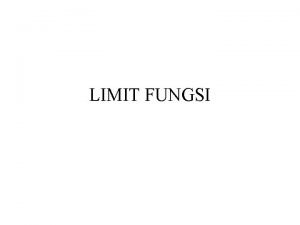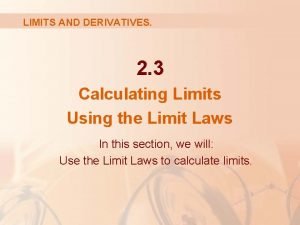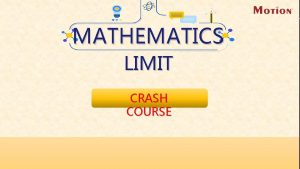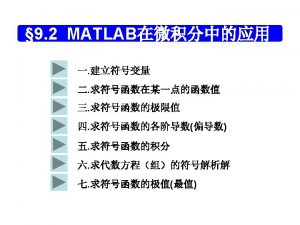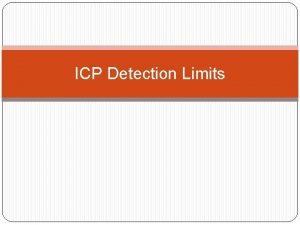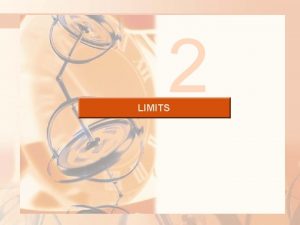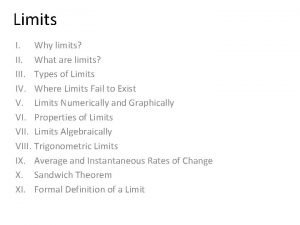Limits What is a Limit Limits are the












- Slides: 12

Limits

What is a Limit? • Limits are the spine that holds the rest of the Calculus skeleton upright. Basically, a limit is a value that tells you what height (y-value) a function is headed for or intended for, as you get close to or approach a specific xvalue. • It describes the behavior of the function as it gets closer to a particular value of x.

Formal Definition of a Limit For a fnc. , f(x), and a real number, c, the limit of f(x) exists if and only if: 1. lim f(x) exists. There must be a limit from the left. 2. lim f(x) exists. There must be a limit from the right. 3. lim f(x) = lim f(x). The limit from the left must equal the limit from the right. (Note: this does not apply to limits as x approaches infinity!)

Evaluating Limits • Look for a pattern in a series or a table • Simple substitution • Use Algebra and/or graph

Evaluate the following limits: 1. ½, 2/3, ¾, 4/5, 5/6, 6/7……. . 2. lim (3 x-1) 3. lim 4. lim 5. lim

Evaluating One-Sided Limits 1. lim 2. lim 3. lim 4. lim

Evaluating Infinite Limits • • • In general, a fractional function will have an infinite limit if the limit of the denominator is zero AND the limit of the numerator is NOT zero. The sign (+/-) of the infinite limit is determined by the sign of the quotient of the numerator and the denominator at values close to the number it is approaching. NOTE: a limit of is actually an indication that a real number limit does not exist (DNE) since it doesn’t make sense to say that the limit is infinitely unlimited!

Evaluate the following Limits: 1. lim 2. lim 3. lim

Limits at Infinity • If the degree of the numerator and denominator are the same, then there is a horizontal asymptote and a limit at the coefficient of the numerator over the coefficient of the denominator. • If the degree of the numerator is larger, then there is a limit at. • If the degree of the denominator is larger, then there is a limit at 0.

Evaluate the following Limits: 1. lim 2. lim 3. lim 4. lim x 3 – x 2 – 3 x

Limits involving Trig Fncs. • lim sin x = sin c • lim cos x = cos c • lim

1. lim 2. lim cot (x) 3. lim 4. lim 5. lim
 Mikael ferm
Mikael ferm Upper specification limit and lower specification limit
Upper specification limit and lower specification limit Pengertian limit fungsi secara intuisi
Pengertian limit fungsi secara intuisi Upper specification limit and lower specification limit
Upper specification limit and lower specification limit Limit laws
Limit laws Real limits statistics
Real limits statistics Limits involving infinity asymptotes
Limits involving infinity asymptotes độ dài liên kết
độ dài liên kết Sự nuôi và dạy con của hươu
Sự nuôi và dạy con của hươu Thiếu nhi thế giới liên hoan
Thiếu nhi thế giới liên hoan Hát lên người ơi
Hát lên người ơi điện thế nghỉ
điện thế nghỉ Một số thể thơ truyền thống
Một số thể thơ truyền thống


